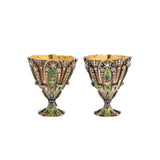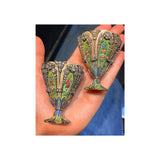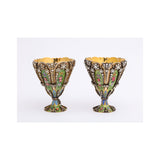Highly Important Museum Quality Pair of Diamond and Enamel Zarfs
A Highly Important Museum Quality Pair of Diamond and Enamel Zarfs.
Each Zarf with a scalloped rim and spreading foot, the sides set with colorful green and pink enamel plaques depicting flower heads and foliage. The stem and the base is a similar diamond-set floral enamel.
A similar single zarf with more diamonds and with emeralds depicted in "The History of Jewelry: Joseph Saidian and Sons" Published by Rizzoli 2019
"A zarf is a small cup that was used for coffee, so it was designed to hold a small container inside in which to put the coffee. Also known as coupelles sur pied, zarfs were often made in Switzerland for the Ottoman market (Boghossian, ed., 2011, p. 87). The interest in coffee grew in the second half of the sixteenth-century as large coffee houses appeared across the vast Ottoman Empire and the popularity of coffee and the act of drinking it amongst the highest levels of society meant that the objects associated with coffee were beautifully made and highly decorative. Men met in coffeehouses to play games such as tavli or trictrac, and listen to music, as well as discuss issues and read newspapers (ibid., p. 87).
Zarfs were highly decorative objects often made in precious metals and inlaid with precious stones or small painted medallions. The metal was often finely wrought or done in filigree They were usually small, and featured a small foot and a larger, round cup on top. A smaller cup, a fincan, often made of ceramic or glass, could then be placed inside the zarf. The fincan does not traditionally have a handle, thus the zarf was a way to protect the drinker from the heat of the coffee. As they were mainly made in Europe for the Ottoman market, they were a mix of Ottoman motifs, such as views of the Bosphorous and European craftsmanship. The European-made zarfs come mainly from the nineteenth-century from such craftsmen as Jean-Valentin Morel. Zarfs were not the only way to drink coffee, an example of a leather coffee cup exists from the eighteenth-century, but this was made in Turkey, not in the high-end markets in Switzerland (ibid., p. 87)
Source: (Boghossian, ed., 2011, p. 87 and Sothebys)
Each Zarf with a scalloped rim and spreading foot, the sides set with colorful green and pink enamel plaques depicting flower heads and foliage. The stem and the base is a similar diamond-set floral enamel.
A similar single zarf with more diamonds and with emeralds depicted in "The History of Jewelry: Joseph Saidian and Sons" Published by Rizzoli 2019
"A zarf is a small cup that was used for coffee, so it was designed to hold a small container inside in which to put the coffee. Also known as coupelles sur pied, zarfs were often made in Switzerland for the Ottoman market (Boghossian, ed., 2011, p. 87). The interest in coffee grew in the second half of the sixteenth-century as large coffee houses appeared across the vast Ottoman Empire and the popularity of coffee and the act of drinking it amongst the highest levels of society meant that the objects associated with coffee were beautifully made and highly decorative. Men met in coffeehouses to play games such as tavli or trictrac, and listen to music, as well as discuss issues and read newspapers (ibid., p. 87).
Zarfs were highly decorative objects often made in precious metals and inlaid with precious stones or small painted medallions. The metal was often finely wrought or done in filigree They were usually small, and featured a small foot and a larger, round cup on top. A smaller cup, a fincan, often made of ceramic or glass, could then be placed inside the zarf. The fincan does not traditionally have a handle, thus the zarf was a way to protect the drinker from the heat of the coffee. As they were mainly made in Europe for the Ottoman market, they were a mix of Ottoman motifs, such as views of the Bosphorous and European craftsmanship. The European-made zarfs come mainly from the nineteenth-century from such craftsmen as Jean-Valentin Morel. Zarfs were not the only way to drink coffee, an example of a leather coffee cup exists from the eighteenth-century, but this was made in Turkey, not in the high-end markets in Switzerland (ibid., p. 87)
Source: (Boghossian, ed., 2011, p. 87 and Sothebys)
 212.752.2684
212.752.2684
 info@saidiansons.com
info@saidiansons.com






